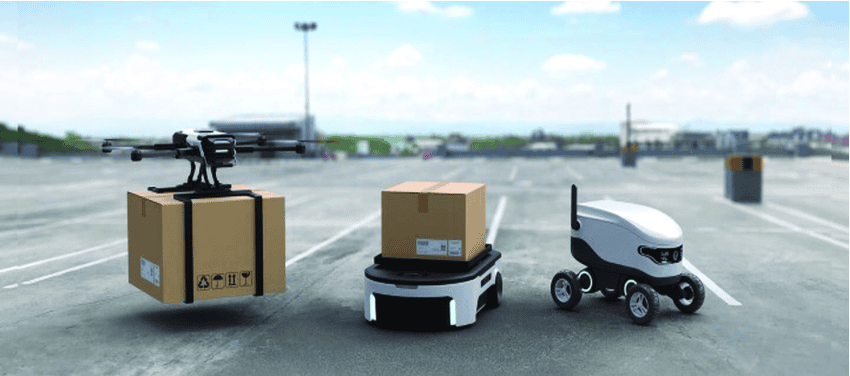The Last Mile Delivery (LMD) Robot Market is predicted to reach USD 30.26 billion with a CAGR of 24.5% by 2030. The expansion of e-commerce, increasing consumer demand for fast and efficient deliveries, and advancements in autonomous vehicle technologies are key factors driving the market’s growth.
Market Overview: The Role of Last Mile Delivery Robots
Last Mile Delivery (LMD) Robot Market refers to the final leg of the delivery process, where goods are transported from a distribution center to the end consumer. This step is often the most time-consuming and costly in the logistics chain. Last mile delivery robots are transforming this process, offering automated, cost-effective, and eco-friendly solutions to meet the growing demands of modern consumers.
See What You’re Missing – Download a FREE Sample Now!
These robots, which include autonomous ground vehicles (AGVs), drones, and sidewalk delivery robots, are being adopted by e-commerce companies, retailers, and logistics providers to enhance delivery efficiency, reduce operational costs, and improve sustainability.
Key Drivers of Market Growth
- E-Commerce Boom: The global e-commerce industry is witnessing exponential growth, with consumers increasingly opting for online shopping. This surge in demand has heightened the need for efficient last mile delivery solutions, positioning LMD robots as a game-changing innovation.
- Technological Advancements: Innovations in artificial intelligence (AI), machine learning (ML) ,and sensor technologies are enabling LMD robots to navigate complex urban environments autonomously. These advancements are enhancing robot reliability and scalability, making them more appealing to businesses.
Try it Risk-Free – Download Your FREE Sample!
- Cost Efficiency: Last mile delivery is a major cost driver in logistics. LMD robots significantly reduce delivery costs by minimizing the reliance on human labor and optimizing fuel consumption. This cost advantage is encouraging businesses to adopt robotic delivery solutions.
- Sustainability Initiatives: Many companies and governments are prioritizing sustainability. LMD robots, which are typically electric-powered and emit lower carbon footprints compared to traditional delivery vehicles, align with global efforts to combat climate change.
- Urbanization and Smart Cities: As urban areas become more densely populated, traditional delivery methods face increasing challenges. LMD robots are well-suited for navigating crowded urban environments, delivering packages efficiently in smart city ecosystems.
Market Segmentation
The LMD robot market can be segmented into several categories based on type, application, and region.
By Type
- Ground Delivery Robots: Autonomous robots designed for sidewalks and streets are the most common type of LMD robots. They are widely used for short-distance deliveries.
- Aerial Drones: Drones offer faster deliveries in urban and rural areas, particularly for lightweight packages.
- Semi-Autonomous Vehicles: These robots combine manual control with automation, providing a hybrid solution for delivery needs.
By Application
- E-Commerce: A significant portion of LMD robots is employed in delivering goods ordered online.
- Retail: Robots are increasingly used for delivering groceries, clothing, and other retail products.
- Healthcare: In the healthcare sector, LMD robots play a crucial role in transporting medical supplies, lab samples, and prescription drugs.
By Region
- North America: The region leads in LMD robot adoption, with major players like Amazon and FedEx pioneering robotic delivery services.
- Europe: Countries like Germany, the UK, and France are investing in LMD technology to enhance logistics efficiency.
- Asia-Pacific: Rapid urbanization and the expansion of e-commerce in countries like China, Japan, and India are driving growth in this region.
- Middle East & Africa: The market in these regions is gradually gaining momentum, supported by government-backed smart city projects.
Industry Innovations and Key Players
The last mile delivery robot market is highly competitive, with leading companies investing heavily in research and development to enhance their offerings. Key players include:
- Starship Technologies: A pioneer in ground delivery robots, known for deploying thousands of autonomous robots in urban areas.
- Amazon Robotics: Amazon continues to innovate with its Scout delivery robots and aerial drone program.
- FedEx: The company’s SameDay Bot is designed to handle deliveries in various environments.
- Nuro: Specializing in autonomous vehicles for last mile delivery, Nuro has partnered with retail giants to redefine logistics.
- Wing (by Alphabet): Wing focuses on drone deliveries, offering fast and efficient aerial delivery solutions.
Challenges in the Market
Despite its rapid growth, the LMD robot market faces several challenges:
- Regulatory Barriers: The deployment of autonomous robots is subject to strict regulations, particularly in urban areas where safety concerns arise.
- High Initial Investment: The cost of developing and deploying LMD robots remains high, which may deter smaller businesses from adopting the technology.
- Infrastructure Limitations: Inadequate infrastructure, such as charging stations and designated delivery zones, can hinder the scalability of robotic delivery services.
- Consumer Acceptance: Some consumers may be hesitant to embrace robotic deliveries due to privacy concerns or unfamiliarity with the technology.
Future Outlook: What Lies Ahead
The future of the LMD robot market is bright, with continued advancements in technology expected to address current challenges. Key trends shaping the industry include:
- Increased Automation: The integration of AI and ML will make robots smarter and more efficient in handling complex delivery scenarios.
- Scalability of Operations: As costs decline and infrastructure improves, LMD robots will become accessible to a wider range of businesses.
- Expansion into Rural Areas: While current deployments are concentrated in urban centers, advancements in drone technology will enable deliveries in remote and rural areas.
- Collaborative Robotics: Companies are exploring ways to combine human and robotic efforts, enhancing delivery efficiency while maintaining a personal touch.
Conclusion
The last mile delivery robot market is set to revolutionize logistics and redefine consumer experiences. With the market projected to reach USD 30.26 billion by 2030, businesses that embrace LMD technology will be well-positioned to meet the demands of a rapidly evolving industry. As automation becomes more prevalent, LMD robots will play a crucial role in shaping the future of delivery and logistics worldwide.
Source: PR News Releaser


Comments